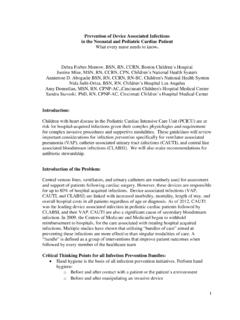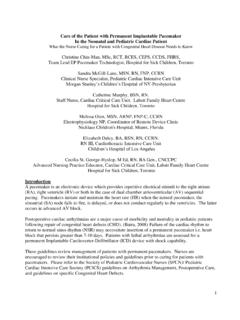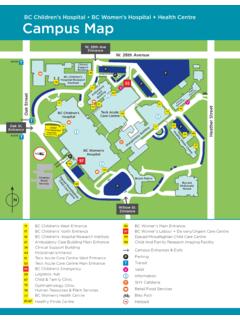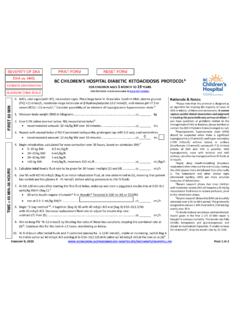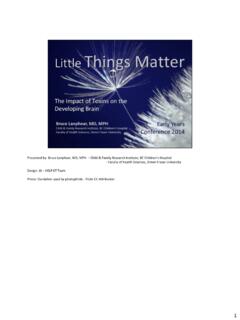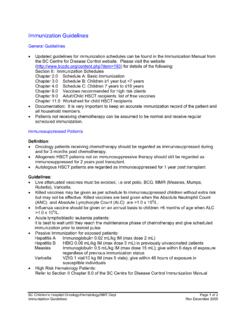Transcription of Neonatal and Pediatric Developmental Guidelines in the ...
1 1 Neonatal and Pediatric Developmental Guidelines in the Care of the Neonate/Child/Adolescent Cardiovascular Patient What the Direct Care Nurse Needs to Know Christine M. Rachwal, RN, MSN, CCRN, Boston children s hospital Flerida Imperial-Perez, MN, RN, CNS-BC, CCNS-P, children s hospital Los Angeles Melanie Guerrero, MSN, RN, CPN, children s hospital Los Angeles Nancy Hagberg, MS, RN, FNP, Child Heart Associates, Worcester, Massachusetts Gwen Rempel, RN, PhD, Athabasca University, Alberta Canada Mary Rummell, MN, RN, CNS, CPNP, FAHA, Oregon Health and Science University Content Outline.
2 Introduction of the Problem Mary Rummell Critical Thinking Points Mary Rummell Diagnostic Evaluation of the Problem Nancy Hagberg Mary Rummell Pre- hospital Preparation of Patients/Parents/ Gwen Rempel Caregivers Developmental Assessment of Pain Flerida Imperial-Perez Providing Developmental Care in the Cardiac Intensive Christine Rachwal Care Unit Providing Developmental Care for Teenagers Melanie Guerrero Poster for Teaching Points for Teen Discharge (Appendix A) Transitions: Between Care Units, hospital to Home Melanie Guerrero Mary Rummell Psychosocial Consequences of Developmental Delay Christine Rachwal Introduction of the Problem: Congenital heart disease (CHD) is the most common birth defect and is responsible for significant childhood morbidity and mortality.
3 With increased understanding of the pathophysiology of CHD and technological advances in early diagnosis, cardio-pulmonary bypass, surgical procedures, and post-operative care more babies are surviving to adulthood. However, with this improved survival rate, as many as half of these children have impaired neurodevelopmental outcomes (Donofrio, 2010; Snookes et al., 2010). Although current practice incorporates the assessment and management of cerebral oxygen delivery and central nervous system function before, during and after surgical interventions, development delays persist.
4 To improve long-term outcomes for these children , standard practice should include neurodevelopmental evaluation, identification of risk factors, and implementation of Developmental interventions provided by an integrated, multidisciplinary team (NACHRI, 2014). 2 Specialized services for identified infants and children may be needed into adulthood (Marino et al., 2012). Critical Thinking Points: children with structural heart defects (whether surgically repaired or not) are at higher risk of neurodevelopmental problems. Risk factors for Developmental delay are present before and after surgery for congenital heart disease.
5 Developmental and maturity problems are identified from infancy through adulthood. Risk factors are both biological and environmental. Biological risk factors include syndromes or genetic/ Developmental disorders, circulatory abnormalities, and required medical and surgical therapies. Environmental factors modify the biological factors at home, school and work. Early identification of Developmental disorders/delays provides children with the best chance of reaching their maximum potential. Appropriate designation of the best provider to oversee the management of Developmental disabilities will facilitate optimal and efficient care.
6 Communication between providers at all stages of interventions is essential to optimal management of Developmental outcomes. Early identification and intervention to prevent further delay decreases long-term sequelae. Diagnostic Evaluation of the Problem Key Points: (Marino 2012) Infants and children with CHD are at increased risk of Developmental disorders/disabilities/delays Continual, periodic Developmental surveillance, screening, evaluation and reevaluation may enhance identification of significant deficits. Evaluation of the child with structural heart disease involves comparing the child s development with key Developmental milestones.
7 Early identification and referral will allow appropriate therapeutic interventions and education to enhance academic behavioral, psychosocial, and adaptive functioning A coordinated care model is essential to address Developmental long-term care needs Developmental interventions include periodic, long-term outpatient evaluation and screening. Prevalence of Developmental delay in the CHD patient (Marino 2012) Increases with complexity of disease Associated with several genetic syndromes 3 Categories of CHD patients at increased risk for Developmental delays o Premature birth o Birth before 39 weeks gestation in neonates with critical CHD o Developmental delay recognized in infancy o Suspected genetic abnormality or syndrome o History of mechanical cardiac support (ECMO, VAD)
8 O Heart transplantation o Cardiopulmonary resuscitation at any point o Prolonged hospitalization (Post-operative length of stay > 2 weeks) o Perioperative seizures related to CHD surgery o Significant abnormalities on neuroimaging or microcephaly Periodic, sequential Developmental evaluation American Academy of Pediatrics recommends children be screened for general development using standardized, validated tools at 9, 18, and 24 or 30 months and for autism at 18 and 24 months OR whenever a parent or provider has a concern. Risk stratification for Developmental delay aids in planning interventions Periodic surveillance of Developmental milestones o Administer screening tool at interval visits between 2 months and 5 years o Available screening tools on web site.
9 Tools available for all recommended age groups 2, 4, 6, 9 months, 1 year, 18 months, 2, 3, 4, 5 years Tools available in English and Spanish Useful in outpatient setting Could also be used in inpatient setting to identify patients for referral Site is also appropriate for parental use Standardized, validated Developmental screening tools available in Pediatrics Volume 118, Number 1, July 2006 410-413 Neurodevelopmental Evaluations structured with a focus on the deficit: o Speech and language testing o Occupational, physical therapy, neuropsychological evaluations Abnormal or delayed assessments should prompt discussions to act early to address o Social/emotional development o Language/communication development o Cognitive (learning, thinking, problem solving)
10 Development o Movement/physical development Referrals o Identify consistent provider to track and manage Developmental care 4 o For children < 5 years and not yet in kindergarten refer to Early Intervention o For children > 5 years refer to school programs or to appropriate provider(s) for formal Developmental and medical evaluation Additional screening strategies: o School aged child Ask the question: How is school going? Refer for formal evaluation Answers that indicate concerns about trouble in school (or at home) either cognitively or socially Answers that may indicate a learning diability o Difficulties with grades, o Teacher concern, o Hating school, o Difficulty completing assignments in a reasonable time o School refusal/multiple absences Answers that may indicate attention deficits o Does not listen o Misses details or makes careless mistakes o Is easily distracted o Has difficulty organizing tasks or activities o Gives up easily on difficult tasks o Is restless or fidgety o Is constantly interrupting.

